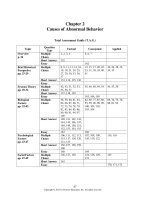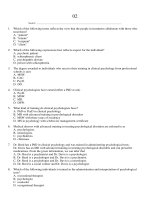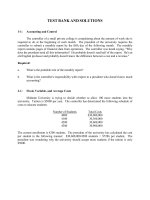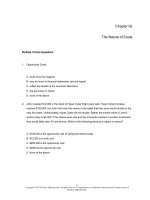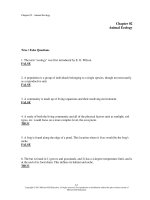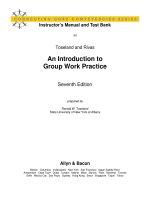Statistics for managers using microsoft excel 7th edition levine test bank
Bạn đang xem bản rút gọn của tài liệu. Xem và tải ngay bản đầy đủ của tài liệu tại đây (1.21 MB, 51 trang )
Statistics for Managers Using Microsoft Excel, 7e (Levine)
Chapter 2 Organizing and Visualizing Data
1) A summary measure that is computed to describe a characteristic from only a sample of the population
is called
A) an ordered array.
B) a summary table.
C) a statistic.
D) a parameter.
Answer: C
Difficulty: Easy
Keywords: statistic
2) A summary measure that is computed to describe a characteristic of an entire population is called
A) a parameter.
B) an ordered array.
C) a statistic.
D) a summary table.
Answer: A
Difficulty: Easy
Keywords: parameter
3) Which of the following is most likely a parameter as opposed to a statistic?
A) the average score of the first five students completing an assignment
B) the proportion of females registered to vote in a county
C) the average height of people randomly selected from a database
D) the proportion of trucks stopped yesterday that were cited for bad brakes
Answer: B
Difficulty: Moderate
Keywords: parameter, statistic
4) The chancellor of a major university was concerned about alcohol abuse on her campus and wanted to
find out the proportion of students at her university who visited campus bars on the weekend before the
final exam week. Her assistant took a random sample of 250 students and computed the portion of
students in the sample who visited campus bars on the weekend before the final exam. The portion of all
students at her university who visited campus bars on the weekend before the final exam week is an
example of
A) a summary table.
B) an ogive.
C) a parameter.
D) a statistic.
Answer: C
Difficulty: Moderate
Keywords: parameter
2-1
Copyright © 2014 Pearson Education, Inc.
5) The chancellor of a major university was concerned about alcohol abuse on her campus and wanted to
find out the proportion of students at her university who visited campus bars on the weekend before the
final exam week. Her assistant took a random sample of 250 students. The portion of students in the
sample who visited campus bars on the weekend before the final exam week is an example of
A) a summary table.
B) an ogive.
C) a parameter.
D) a statistic
Answer: D
Difficulty: Moderate
Keywords: statistic
6) True or False: A statistic is usually used to provide an estimate for a usually unobserved parameter.
Answer: TRUE
Difficulty: Moderate
Keywords: statistic, parameter, inferential statistic
7) True or False: A statistic is usually unobservable while a parameter is usually observable.
Answer: FALSE
Difficulty: Moderate
Keywords: statistic, parameter, inferential statistic
8) The Human Resources Director of a large corporation wishes to develop an employee benefits package
and decides to select 500 employees from a list of all (N = 40,000) workers in order to study their
preferences for the various components of a potential package. The Director will use the data from the
sample to compute ________.
Answer: statistics
Difficulty: Easy
Keywords: statistic
9) The Human Resources Director of a large corporation wishes to develop an employee benefits package
and decides to select 500 employees from a list of all (N = 40,000) workers in order to study their
preferences for the various components of a potential package. Information obtained from the sample
will be used to draw conclusions about the true population ________.
Answer: parameters
Difficulty: Easy
Keywords: parameter
10) The oranges grown in corporate farms in an agricultural state were damaged by some unknown fungi
a few years ago. Suppose the manager of a large farm wanted to study the impact of the fungi on the
orange crops on a daily basis over a 6-week period. On each day a random sample of orange trees was
selected from within a random sample of acres. The daily average number of damaged oranges per tree
and the proportion of trees having damaged oranges were calculated. The two main measures calculated
each day (i.e., average number of damaged oranges per tree and proportion of trees having damaged
oranges) are called ________.
Answer: statistics
Difficulty: Moderate
Keywords: statistic
2-2
Copyright © 2014 Pearson Education, Inc.
11) The oranges grown in corporate farms in an agricultural state were damaged by some unknown fungi
a few years ago. Suppose the manager of a large farm wanted to study the impact of the fungi on the
orange crops on a daily basis over a 6-week period. On each day a random sample of orange trees was
selected from within a random sample of acres. The daily average number of damaged oranges per tree
and the proportion of trees having damaged oranges were calculated. The two main measures calculated
each day (i.e., average number of damaged oranges per tree and proportion of trees having damaged
oranges) may be used on a daily basis to estimate the respective true population ________.
Answer: parameters
Difficulty: Easy
Keywords: parameters
12) The Quality Assurance Department of a large urban hospital is attempting to monitor and evaluate
patient satisfaction with hospital services. Prior to discharge, a random sample of patients is asked to fill
out a questionnaire to rate such services as medical care, nursing, therapy, laboratory, food, and cleaning.
The Quality Assurance Department prepares weekly reports that are presented at the Board of Directors
meetings and extraordinary/atypical ratings are easy to flag. Values computed from the sample results
each week are called ________.
Answer: statistics
Difficulty: Easy
Keywords: statistic
13) The Quality Assurance Department of a large urban hospital is attempting to monitor and evaluate
patient satisfaction with hospital services. Prior to discharge, a random sample of patients is asked to fill
out a questionnaire to rate such services as medical care, nursing, therapy, laboratory, food, and cleaning.
The Quality Assurance Department prepares weekly reports that are presented at the Board of Directors
meetings and extraordinary/atypical ratings are easy to flag. True population characteristics estimated
from the sample results each week are called ________.
Answer: parameters
Difficulty: Easy
Keywords: parameter
14) The Commissioner of Health in New York State wanted to study malpractice litigation in New York.
A sample of 31 thousand medical records was drawn from a population of 2.7 million patients who were
discharged during 2010. The proportion of malpractice claims filed from the sample of 31 thousand
patients is a ________.
Answer: statistic
Difficulty: Moderate
Keywords: statistic
15) The Commissioner of Health in New York State wanted to study malpractice litigation in New York.
A sample of 31 thousand medical records was drawn from a population of 2.7 million patients who were
discharged during 2010. The true proportion of malpractice claims filed from the population of 2.7
million patients is a ________.
Answer: parameter
Difficulty: Easy
Keywords: parameter
2-3
Copyright © 2014 Pearson Education, Inc.
TABLE 2-1
An insurance company evaluates many numerical variables about a person before deciding on an
appropriate rate for automobile insurance. A representative from a local insurance agency selected a
random sample of insured drivers and recorded, X, the number of claims each made in the last 3 years,
with the following results.
X
1
2
3
4
5
f
14
18
12
5
1
16) Referring to Table 2-1, how many drivers are represented in the sample?
A) 5
B) 15
C) 18
D) 50
Answer: D
Difficulty: Easy
Keywords: frequency distribution
17) Referring to Table 2-1, how many total claims are represented in the sample?
A) 15
B) 50
C) 111
D) 250
Answer: C
Difficulty: Moderate
Keywords: interpretation, frequency distribution
18) A type of vertical bar chart in which the categories are plotted in the descending rank order of the
magnitude of their frequencies is called a
A) contingency table.
B) Pareto chart.
C) stem-and-leaf display.
D) pie chart.
Answer: B
Difficulty: Easy
Keywords: Pareto chart
2-4
Copyright © 2014 Pearson Education, Inc.
TABLE 2-2
At a meeting of information systems officers for regional offices of a national company, a survey was
taken to determine the number of employees the officers supervise in the operation of their departments,
where X is the number of employees overseen by each information systems officer.
X
1
2
3
4
5
f
7
5
11
8
9
19) Referring to Table 2-2, how many regional offices are represented in the survey results?
A) 5
B) 11
C) 15
D) 40
Answer: D
Difficulty: Easy
Keywords: interpretation, frequency distribution
20) Referring to Table 2-2, across all of the regional offices, how many total employees were supervised
by those surveyed?
A) 15
B) 40
C) 127
D) 200
Answer: C
Difficulty: Moderate
Keywords: interpretation, frequency distribution
21) The width of each bar in a histogram corresponds to the
A) differences between the boundaries of the class.
B) number of observations in each class.
C) midpoint of each class.
D) percentage of observations in each class.
Answer: A
Difficulty: Easy
Keywords: frequency distribution
2-5
Copyright © 2014 Pearson Education, Inc.
TABLE 2-3
Every spring semester, the School of Business coordinates a luncheon with local business leaders for
graduating seniors, their families, and friends. Corporate sponsorship pays for the lunches of each of the
seniors, but students have to purchase tickets to cover the cost of lunches served to guests they bring with
them. The following histogram represents the attendance at the senior luncheon, where X is the number
of guests each graduating senior invited to the luncheon and f is the number of graduating seniors in each
category.
22) Referring to the histogram from Table 2-3, how many graduating seniors attended the luncheon?
A) 4
B) 152
C) 275
D) 388
Answer: C
Explanation: C) The number of graduating seniors is the sum of all the frequencies, f.
Difficulty: Difficult
Keywords: interpretation, histogram
23) Referring to the histogram from Table 2-3, if all the tickets purchased were used, how many guests
attended the luncheon?
A) 4
B) 152
C) 275
D) 388
Answer: D
Explanation: D) The total number of guests is
.
Difficulty: Difficult
Keywords: interpretation, histogram
2-6
Copyright © 2014 Pearson Education, Inc.
24) A professor of economics at a small Texas university wanted to determine what year in school
students were taking his tough economics course. Shown below is a pie chart of the results. What
percentage of the class took the course prior to reaching their senior year?
A) 14%
B) 44%
C) 54%
D) 86%
Answer: D
Difficulty: Easy
Keywords: interpretation, pie chart
25) When polygons or histograms are constructed, which axis must show the true zero or "origin"?
A) The horizontal axis
B) The vertical axis
C) Both the horizontal and vertical axes
D) Neither the horizontal nor the vertical axis
Answer: B
Difficulty: Easy
Keywords: polygon, histogram
26) When constructing charts, the following is plotted at the class midpoints:
A) frequency histograms.
B) percentage polygons.
C) cumulative percentage polygon (ogives).
D) All of the above.
Answer: B
Difficulty: Easy
Keywords: percentage polygon
2-7
Copyright © 2014 Pearson Education, Inc.
TABLE 2-4
A survey was conducted to determine how people rated the quality of programming available on
television. Respondents were asked to rate the overall quality from 0 (no quality at all) to 100 (extremely
good quality). The stem-and-leaf display of the data is shown below.
Stem
3
4
5
6
7
8
9
Leaves
24
03478999
0112345
12566
01
2
27) Referring to Table 2-4, what percentage of the respondents rated overall television quality with a
rating of 80 or above?
A) 0
B) 4
C) 96
D) 100
Answer: B
Difficulty: Easy
Keywords: stem-and-leaf display, interpretation
28) Referring to Table 2-4, what percentage of the respondents rated overall television quality with a
rating of 50 or below?
A) 11
B) 40
C) 44
D) 56
Answer: C
Difficulty: Moderate
Keywords: stem-and-leaf display, interpretation
29) Referring to Table 2-4, what percentage of the respondents rated overall television quality with a
rating from 50 through 75?
A) 11
B) 40
C) 44
D) 56
Answer: D
Difficulty: Moderate
Keywords: stem-and-leaf display, interpretation
2-8
Copyright © 2014 Pearson Education, Inc.
TABLE 2-5
The following are the duration in minutes of a sample of long-distance phone calls made within the
continental United States reported by one long-distance carrier.
Time (in Minutes)
0 but less than 5
5 but less than 10
10 but less than 15
15 but less than 20
20 but less than 25
25 but less than 30
30 or more
Relative
Frequency
0.37
0.22
0.15
0.10
0.07
0.07
0.02
30) Referring to Table 2-5, what is the width of each class?
A) 1 minute
B) 5 minutes
C) 2%
D) 100%
Answer: B
Difficulty: Easy
Keywords: class interval, relative frequency distribution
31) Referring to Table 2-5, if 1,000 calls were randomly sampled, how many calls lasted under 10
minutes?
A) 220
B) 370
C) 410
D) 590
Answer: D
Difficulty: Moderate
Keywords: relative frequency distribution, interpretation
32) Referring to Table 2-5, if 100 calls were randomly sampled, how many calls lasted 15 minutes or
longer?
A) 10
B) 14
C) 26
D) 74
Answer: C
Difficulty: Moderate
Keywords: relative frequency distribution, interpretation
2-9
Copyright © 2014 Pearson Education, Inc.
33) Referring to Table 2-5, if 10 calls lasted 30 minutes or more, how many calls lasted less than 5
minutes?
A) 10
B) 185
C) 295
D) 500
Answer: B
Difficulty: Moderate
Keywords: relative frequency distribution, interpretation
34) Referring to Table 2-5, what is the cumulative relative frequency for the percentage of calls that lasted
under 20 minutes?
A) 0.10
B) 0.59
C) 0.76
D) 0.84
Answer: D
Difficulty: Easy
Keywords: cumulative relative frequency
35) Referring to Table 2-5, what is the cumulative relative frequency for the percentage of calls that lasted
10 minutes or more?
A) 0.16
B) 0.24
C) 0.41
D) 0.90
Answer: C
Difficulty: Moderate
Keywords: cumulative relative frequency
36) Referring to Table 2-5, if 100 calls were randomly sampled, ________ of them would have lasted at
least 15 minutes but less than 20 minutes
A) 6
B) 8
C) 10
D) 16
Answer: C
Difficulty: Easy
Keywords: relative frequency distribution, interpretation
2-10
Copyright © 2014 Pearson Education, Inc.
37) Referring to Table 2-5, if 100 calls were sampled, ________ of them would have lasted less than 15
minutes.
A) 26
B) 74
C) 10
D) None of the above.
Answer: B
Difficulty: Moderate
Keywords: relative frequency distribution, interpretation
38) Referring to Table 2-5, if 100 calls were sampled, ________ of them would have lasted 20 minutes or
more.
A) 26
B) 16
C) 74
D) None of the above.
Answer: B
Difficulty: Moderate
Keywords: relative frequency distribution, interpretation
39) Referring to Table 2-5, if 100 calls were sampled, ________ of them would have lasted less than 5
minutes or at least 30 minutes or more.
A) 35
B) 37
C) 39
D) None of the above.
Answer: C
Difficulty: Difficult
Keywords: relative frequency distribution, interpretation
40) Which of the following is appropriate for displaying data collected on the different brands of cars
students at a major university drive?
A) A Pareto chart
B) A two-way classification table
C) A histogram
D) A scatter plot
Answer: A
Difficulty: Easy
Keywords: Pareto diagram
2-11
Copyright © 2014 Pearson Education, Inc.
41) One of the developing countries is experiencing a baby boom, with the number of births rising for the
fifth year in a row, according to a BBC News report. Which of the following is best for displaying this
data?
A) A Pareto chart
B) A two-way classification table
C) A histogram
D) A time-series plot
Answer: D
Difficulty: Easy
Keywords: time-series plot
42) When studying the simultaneous responses to two categorical questions, you should set up a
A) contingency table
B) frequency distribution table
C) cumulative percentage distribution table
D) histogram
Answer: A
Difficulty: Easy
Keywords: contingency table
43) Data on 1,500 students' height were collected at a larger university in the East Coast. Which of the
following is the best chart for presenting the information?
A) a pie chart
B) a Pareto chart
C) a side-by-side bar chart
D) a histogram
Answer: D
Difficulty: Easy
Keywords: choice of chart, histogram
44) Data on the number of part-time hours students at a public university worked in a week were
collected. Which of the following is the best chart for presenting the information?
A) a pie chart
B) a Pareto chart
C) a percentage table
D) a percentage polygon
Answer: D
Difficulty: Easy
Keywords: choice of chart, percentage polygon
2-12
Copyright © 2014 Pearson Education, Inc.
45) Data on the number of credit hours of 20,000 students at a public university enrolled in a spring
semester were collected. Which of the following is the best for presenting the information?
A) a pie chart
B) a Pareto chart
C) a stem-and-leaf display
D) a contingency table
Answer: C
Difficulty: Easy
Keywords: choice of chart, stem-and-leaf
46) A survey of 150 executives were asked what they think is the most common mistake candidates make
during job interviews. Six different mistakes were given. Which of the following is the best for presenting
the information?
A) a bar chart.
B) a histogram
C) a stem-and-leaf display
D) a contingency table
Answer: A
Difficulty: Easy
Keywords: choice of chart, bar chart
47) You have collected information on the market share of 5 different search engines used by U.S. Internet
users in a particular quarter. Which of the following is the best for presenting the information?
A) a pie chart
B) a histogram
C) a stem-and-leaf display
D) a contingency table
Answer: A
Difficulty: Easy
Keywords: choice of chart, pie chart
48) You have collected information on the consumption by the 15 largest coffee-consuming nations.
Which of the following is the best for presenting the shares of the consumption?
A) a pie chart
B) a Pareto chart
C) a side-by-side bar chart
D) a contingency table
Answer: B
Explanation: B) NOTE: Even though a pie chart can also be used, the Pareto chart is preferable for
separating the "vital few" from the "trivial many."
Difficulty: Moderate
Keywords: choice of chart, Pareto chart
2-13
Copyright © 2014 Pearson Education, Inc.
49) You have collected data on the approximate retail price (in $) and the energy cost per year (in $) of 15
refrigerators. Which of the following is the best for presenting the data?
A) a pie chart
B) a scatter plot
C) a side-by-side bar chart
D) a contingency table
Answer: B
Difficulty: Easy
Keywords: choice of chart, scatter plot
50) You have collected data on the number of U.S. households actively using online banking and/or
online bill payment over a 10-year period. Which of the following is the best for presenting the data?
A) a pie chart
B) a stem-and-leaf display
C) a side-by-side bar chart
D) a time-series plot
Answer: D
Difficulty: Easy
Keywords: choice of chart, time-series plot
51) You have collected data on the monthly seasonally adjusted civilian unemployment rate for the
United States over a 10-year period. Which of the following is the best for presenting the data?
A) a contingency table
B) a stem-and-leaf display
C) a time-series plot
D) a side-by-side bar chart
Answer: C
Difficulty: Easy
Keywords: choice of chart, time-series plot
52) You have collected data on the number of complaints for 6 different brands of automobiles sold in the
United States over a 10-year period. Which of the following is the best for presenting the data?
A) a contingency table
B) a stem-and-leaf display
C) a time-series plot
D) a side-by-side bar chart
Answer: D
Difficulty: Moderate
Keywords: choice of chart, side-by-side bar chart
2-14
Copyright © 2014 Pearson Education, Inc.
53) You have collected data on the responses to two questions asked in a survey of 40 college students
majoring in business–"What is your gender (Male = M; Female = F)?" and "What is your major
(Accountancy = A; Computer Information Systems = C; Marketing = M)?" Which of the following is the
best for presenting the data?
A) a contingency table
B) a stem-and-leaf display
C) a time-series plot
D) a Pareto chart
Answer: A
Difficulty: Moderate
Keywords: choice of chart, contingency table
TABLE 2-6
A sample of 200 students at a Big-Ten university was taken after the midterm to ask them whether they
went bar hopping the weekend before the midterm or spent the weekend studying, and whether they did
well or poorly on the midterm. The following table contains the result.
Studying for Exam
Went Bar Hopping
Did Well in Midterm
80
30
Did Poorly in Midterm
20
70
54) Referring to Table 2-6, of those who went bar hopping the weekend before the midterm in the sample,
________ percent of them did well on the midterm.
A) 15
B) 27.27
C) 30
D) 55
Answer: C
Difficulty: Easy
Keywords: contingency table, interpretation
55) Referring to Table 2-6, of those who did well on the midterm in the sample, ________ percent of them
went bar hopping the weekend before the midterm.
A) 15
B) 27.27
C) 30
D) 50
Answer: B
Difficulty: Easy
Keywords: contingency table, interpretation
2-15
Copyright © 2014 Pearson Education, Inc.
56) Referring to Table 2-6, ________ percent of the students in the sample went bar hopping the weekend
before the midterm and did well on the midterm.
A) 15
B) 27.27
C) 30
D) 50
Answer: A
Difficulty: Easy
Keywords: contingency table, interpretation
57) Referring to Table 2-6, ________ percent of the students in the sample spent the weekend studying
and did well on the midterm.
A) 40
B) 50
C) 72.72
D) 80
Answer: A
Difficulty: Easy
Keywords: contingency table, interpretation
58) Referring to Table 2-6, if the sample is a good representation of the population, we can expect
________ percent of the students in the population to spend the weekend studying and do poorly on the
midterm.
A) 10
B) 20
C) 45
D) 50
Answer: A
Difficulty: Easy
Keywords: contingency table, interpretation
59) Referring to Table 2-6, if the sample is a good representation of the population, we can expect
________ percent of those who spent the weekend studying to do poorly on the midterm.
A) 10
B) 20
C) 45
D) 50
Answer: B
Difficulty: Moderate
Keywords: contingency table, interpretation
2-16
Copyright © 2014 Pearson Education, Inc.
60) Referring to Table 2-6, if the sample is a good representation of the population, we can expect
________ percent of those who did poorly on the midterm to have spent the weekend studying.
A) 10
B) 22
C) 45
D) 50
Answer: B
Difficulty: Moderate
Keywords: contingency table, interpretation
61) In a contingency table, the number of rows and columns
A) must always be the same.
B) must always be 2.
C) must add to 100%.
D) None of the above.
Answer: D
Difficulty: Moderate
Keywords: contingency table
62) Retailers are always interested in determining why a customer selected their store to make a
purchase. A sporting goods retailer conducted a customer survey to determine why its customers
shopped at the store. The results are shown in the bar chart below. What proportion of the customers
responded that they shopped at the store because of the merchandise or the convenience?
A) 35%
B) 50%
C) 65%
D) 85%
Answer: C
Difficulty: Easy
Keywords: bar chart, interpretation
2-17
Copyright © 2014 Pearson Education, Inc.
TABLE 2-7
The Stem-and-Leaf display below contains data on the number of months between the date a civil suit is
filed and when the case is actually adjudicated for 50 cases heard in superior court.
Stem
1
2
3
4
5
6
Leaves
234447899
22223455678889
0011135778
02345579
112466
158
63) Referring to Table 2-7, locate the first leaf, i.e., the lowest valued leaf with the lowest valued stem.
This represents a wait of ________ months.
Answer: 12
Difficulty: Easy
Keywords: stem-and-leaf display, interpretation
64) Referring to Table 2-7, the civil suit with the longest wait between when the suit was filed and when it
was adjudicated had a wait of ________ months.
Answer: 68
Difficulty: Easy
Keywords: stem-and-leaf display, interpretation
65) Referring to Table 2-7, the civil suit with the fourth shortest waiting time between when the suit was
filed and when it was adjudicated had a wait of ________ months.
Answer: 14
Difficulty: Moderate
Keywords: stem-and-leaf display, interpretation
66) Referring to Table 2-7, ________ percent of the cases were adjudicated within the first 2 years.
Answer: 30
Difficulty: Moderate
Keywords: stem-and-leaf display, interpretation
67) Referring to Table 2-7, ________ percent of the cases were not adjudicated within the first 4 years.
Answer: 20
Difficulty: Moderate
Keywords: stem-and-leaf display, interpretation
68) Referring to Table 2-7, if a frequency distribution with equal sized classes was made from this data,
and the first class was "10 but less than 20," the frequency of that class would be ________.
Answer: 9
Difficulty: Easy
Keywords: stem-and-leaf display, interpretation
2-18
Copyright © 2014 Pearson Education, Inc.
69) Referring to Table 2-7, if a frequency distribution with equal sized classes was made from this data,
and the first class was "10 but less than 20," the relative frequency of the third class would be ________.
Answer: 0.20 or 20% or 10/50
Difficulty: Moderate
Keywords: stem-and-leaf display, relative frequency distribution
70) Referring to Table 2-7, if a frequency distribution with equal sized classes was made from this data,
and the first class was "10 but less than 20," the cumulative percentage of the second class would be
________.
Answer: 46% or 0.46 or 23/50
Difficulty: Moderate
Keywords: stem-and-leaf display, cumulative percentage distribution
TABLE 2-8
The Stem-and-Leaf display represents the number of times in a year that a random sample of 100
"lifetime" members of a health club actually visited the facility.
Stem
0
1
2
3
4
5
6
7
8
9
Leaves
012222233333344566666667789999
1111222234444455669999
00011223455556889
0000446799
011345567
0077
8
67
3
0247
71) Referring to Table 2-8, the person who has the largest leaf associated with the smallest stem visited
the facility ________ times.
Answer: 9
Difficulty: Moderate
Keywords: stem-and-leaf display, interpretation
72) Referring to Table 2-8, the person who visited the health club less than anyone else in the sample
visited the facility ________ times.
Answer: 0 or no
Difficulty: Easy
Keywords: stem-and-leaf display, interpretation
73) Referring to Table 2-8, the person who visited the health club more than anyone else in the sample
visited the facility ________ times.
Answer: 97
Difficulty: Easy
Keywords: stem-and-leaf display, interpretation
2-19
Copyright © 2014 Pearson Education, Inc.
74) Referring to Table 2-8, ________ of the 100 members visited the health club at least 52 times in a year.
Answer: 10
Difficulty: Moderate
Keywords: stem-and-leaf display, interpretation
75) Referring to Table 2-8, ________ of the 100 members visited the health club no more than 12 times in a
year.
Answer: 38
Difficulty: Moderate
Keywords: stem-and-leaf display, interpretation
76) Referring to Table 2-8, if a frequency distribution with equal sized classes was made from this data,
and the first class was "0 but less than 10," the frequency of the fifth class would be ________.
Answer: 9
Difficulty: Moderate
Keywords: stem-and-leaf display, frequency distribution
77) Referring to Table 2-8, if a frequency distribution with equal sized classes was made from this data,
and the first class was "0 but less than 10," the relative frequency of the last class would be ________.
Answer: 4% or 0.04 or 4/100
Difficulty: Moderate
Keywords: stem-and-leaf display, relative frequency distribution
78) Referring to Table 2-8, if a frequency distribution with equal sized classes was made from this data,
and the first class was "0 but less than 10," the cumulative percentage of the next-to-last class would be
________.
Answer: 96% or 0.96 or 96/100
Difficulty: Moderate
Keywords: stem-and-leaf display, cumulative percentage distribution
79) Referring to Table 2-8, if a frequency distribution with equal sized classes was made from this data,
and the first class was "0 but less than 10," the class midpoint of the third class would be ________.
Answer: 25 or (20 + 30)/2
Difficulty: Moderate
Keywords: stem-and-leaf display, class midpoint
2-20
Copyright © 2014 Pearson Education, Inc.
TABLE 2-9
The frequency distribution below represents the rents of 250 randomly selected federally subsidized
apartments in a small town.
Rent in $
1,100 but less than 1,200
1,200 but less than 1,300
1,300 but less than 1,400
1,400 but less than 1,500
1,500 but less than 1,600
Frequency
113
85
32
16
4
80) Referring to Table 2-9, ________ apartments rented for at least $1,200 but less than $1,400.
Answer: 117
Difficulty: Easy
Keywords: frequency distribution
81) Referring to Table 2-9, ________ of the apartments rented for $1,400 or more.
Answer: 8% or 20/250
Difficulty: Easy
Keywords: frequency distribution, cumulative percentage distribution
82) Referring to Table 2-9, ________ of the apartments rented for at least $1,300.
Answer: 20.8% or 52/250
Difficulty: Moderate
Keywords: frequency distribution, cumulative percentage distribution
83) Referring to Table 2-9, the class midpoint of the second class is ________.
Answer: 1,250
Difficulty: Easy
Keywords: frequency distribution, class midpoint
84) Referring to Table 2-9, the relative frequency of the second class is ________.
Answer: 85/250 or 17/50 or 34% or 0.34
Difficulty: Easy
Keywords: frequency distribution, relative frequency distribution
85) Referring to Table 2-9, the percentage of apartments renting for less than $1,400 is ________.
Answer: 230/250 or 23/25 or 92% or 0.92
Difficulty: Moderate
Keywords: frequency distribution, cumulative percentage distribution
2-21
Copyright © 2014 Pearson Education, Inc.
TABLE 2-10
The histogram below represents scores achieved by 200 job applicants on a personality profile.
86) Referring to the histogram from Table 2-10, ________ percent of the job applicants scored between 10
and 20.
Answer: 20
Difficulty: Easy
Keywords: histogram, percentage distribution
87) Referring to the histogram from Table 2-10, ________ percent of the job applicants scored below 50.
Answer: 80
Difficulty: Moderate
Keywords: histogram, percentage distribution
88) Referring to the histogram from Table 2-10, the number of job applicants who scored between 30 and
below 60 is ________.
Answer: 80
Difficulty: Moderate
Keywords: histogram
89) Referring to the histogram from Table 2-10, the number of job applicants who scored 50 or above is
________.
Answer: 40
Difficulty: Moderate
Keywords: histogram
90) Referring to the histogram from Table 2-10, 90% of the job applicants scored above or equal to
________.
Answer: 10
Difficulty: Moderate
Keywords: histogram, cumulative percentage distribution
2-22
Copyright © 2014 Pearson Education, Inc.
91) Referring to the histogram from Table 2-10, half of the job applicants scored below ________.
Answer: 30
Difficulty: Moderate
Keywords: histogram, cumulative percentage distribution
92) Referring to the histogram from Table 2-10, ________ percent of the applicants scored below 20 or at
least 50.
Answer: 50
Difficulty: Moderate
Keywords: histogram, cumulative percentage distribution
93) Referring to the histogram from Table 2-10, ________ percent of the applicants scored between 20 and
below 50.
Answer: 50
Difficulty: Moderate
Keywords: histogram, cumulative percentage distribution
TABLE 2-11
The ordered array below resulted from selecting a sample of 25 batches of 500 computer chips and
determining how many in each batch were defective.
Defects
1
2
17 20
4
21
4
23
5
23
5
25
6
26
7
27
9
27
9
28
12
29
12
29
15
94) Referring to Table 2-11, if a frequency distribution for the defects data is constructed, using "0 but less
than 5" as the first class, the frequency of the "20 but less than 25" class would be ________.
Answer: 4
Difficulty: Easy
Keywords: frequency distribution
95) Referring to Table 2-11, if a frequency distribution for the defects data is constructed, using "0 but less
than 5" as the first class, the relative frequency of the "15 but less than 20" class would be ________.
Answer: 0.08 or 8% or 2/25
Difficulty: Moderate
Keywords: relative frequency distribution
2-23
Copyright © 2014 Pearson Education, Inc.
96) Referring to Table 2-11, construct a frequency distribution for the defects data, using "0 but less than
5" as the first class.
Answer:
Defects
Frequency
0 but less than 5
4
5 but less than 10
6
10 but less than 15
2
15 but less than 20
2
20 but less than 25
4
25 but less than 30
7
Difficulty: Easy
Keywords: frequency distribution
97) Referring to Table 2-11, construct a relative frequency or percentage distribution for the defects data,
using "0 but less than 5" as the first class.
Answer:
Defects
Percentage
0 but less than 5
16
5 but less than 10
24
10 but less than 15
8
15 but less than 20
8
20 but less than 25
16
25 but less than 30
28
Difficulty: Moderate
Keywords: relative frequency distribution, percentage distribution
98) Referring to Table 2-11, construct a cumulative percentage distribution for the defects data if the
corresponding frequency distribution uses "0 but less than 5" as the first class.
Answer:
Defects
CumPct
0
0
5
16
10
40
15
48
20
56
25
72
30
100
Difficulty: Moderate
Keywords: cumulative percentage distribution
2-24
Copyright © 2014 Pearson Education, Inc.
99) Referring to Table 2-11, construct a histogram for the defects data, using "0 but less than 5" as the first
class.
Answer:
Difficulty: Easy
Keywords: histogram, frequency distribution
100) Referring to Table 2-11, construct a cumulative percentage polygon for the defects data if the
corresponding frequency distribution uses "0 but less than 5" as the first class.
Answer:
Difficulty: Moderate
Keywords: cumulative percentage polygon
2-25
Copyright © 2014 Pearson Education, Inc.

